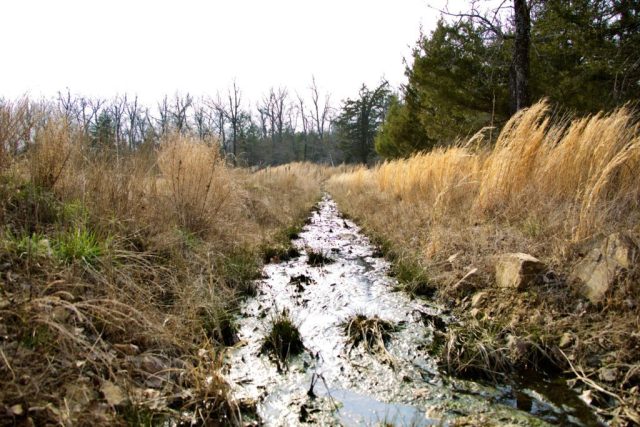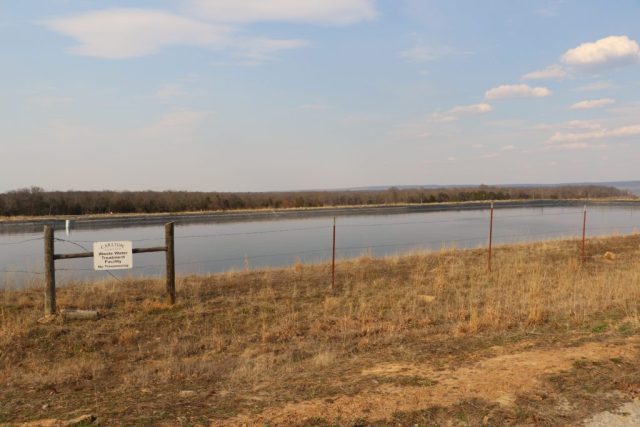
The Oklahoma Department of Environmental Quality has issued its second order in less than a month against the town of Carlton Landing’s water district after it pumped tens of thousands of gallons of water from its sewage lagoons using an unpermitted system to discharge the water, with the runoff flowing into Lake Eufaula, DEQ records state.
And, following revelations last month that the town’s water district had pumped millions of gallons of water from its lagoons onto U.S. Army Corps of Engineers land and into Lake Eufaula, the Corps of Engineers has halted progress on building projects on public land the town has requested, records show.
The latest DEQ order, an administrative compliance order issued on April 11, fined Carlton Landing’s water district up to $33,750 for allegedly installing and using an unpermitted land application system (which resemble large sprinkler systems) to pump more than 34,000 gallons of water out of the town’s sewage lagoons onto nearby land on March 25, which flowed into Lake Eufaula, the order states.
Four days prior to the incident, the town’s water district had been placed under a DEQ consent order that, among other things, came after the water district pumped millions of gallons of water from the lagoons onto U.S. Army Corps of Engineers land that had been leased to the town for development and into Lake Eufaula, DEQ records show.
An investigation by The Frontier late last month found that the town’s water district and administrators had been warned for years by Oklahoma Department of Environmental Quality inspectors to make repairs and improvements to its sewage lagoon and wastewater system. Rainwater was collecting in the system and causing the town’s three sewage lagoons to fill rapidly, and in some cases overflow, DEQ records show. The town’s three cell total retention sewage lagoons are located a few hundred feet uphill from Lake Eufaula, and next to the 420 acres leased from the U.S. Army Corps of Engineers.
On Monday, DEQ issued a permit variance allowing Carlton Landing to land-apply the wastewater from its sewage lagoons in a location about a mile west of the lagoon system.
The town’s founder and developer Grant Humphreys told The Frontier that the town’s water district is working to build a new wastewater treatment plant, but is waiting on DEQ approval of the system.
Since the March 25 discharge, the water district has been in compliance with DEQ regulations, Humphreys said, and the water discharged was mostly rainwater that had infiltrated the town’s wastewater system, causing the lagoons to fill rapidly. DEQ was notified about the bypass through the land application system prior to the discharge taking place, he said.
“We’ve got an undersized treatment system for the demand that we have and until we get a permit from DEQ that lets us expand our capacity, we can’t change the inflow and we can’t change the limited treatment capacity of the system,” Humphreys said. “What we released was treated wastewater that was tested and found to be safe.”
Carlton Landing, which was officially incorporated as a town in 2013, was the vision of Humphreys, an Oklahoma City developer and son of former Oklahoma City Mayor Kirk Humphreys (who is an investor in the project) in 2007. Based on the tenets of New Urbanism and sustainability, Carlton Landing’s homes, unique architecture, and location on the shores of Lake Eufaula, just south of the town of Eufaula, have been a selling point for the development.
Millions of dollars have been invested into building the town.
“From the beginning, Carlton Landing has been designed with sustainability as a core value,” Humphreys said. “It’s something we’re really passionate about. We consider ecological stewardship to be something we are called to do. We take it very seriously.”

Grant Humphreys testifies before the U.S. Senate’s Environment and Public Works Committee Subcommittee on Transportation and Infrastructure on May 9, 2017. COURTESY
However, Humphreys said, the town’s sewer lagoons are undersized, and have filled rapidly with mostly rainwater that got into the system through holes and cracks in the town’s wastewater system. The other option besides intentionally discharging the water would be letting the lagoons overflow, which could erode the lagoon dikes and cause a massive spill into the lake.
“The bypass, if we did nothing, would just run over the top of the lagoons, leading to erosion and a loss of structural integrity of the lagoon itself,” Humphreys said. “The aerated system that we informed DEQ we would be using, that we utilized, was done with the intent of minimizing those environmental impacts and minimizing the risk of lagoon failure.”
Following publication of The Frontier’s investigation, on March 28, Terry Rupe, chief of the real estate division for the Corps of Engineer’s Tulsa District, sent a letter to Carlton Landing Mayor Joanne Chinnici and the town’s water district stating that all lines crossing the leased property must immediately be removed and the town must cease any unpermitted discharges from the lagoons.
According to Rupe’s letter, Carlton Landing was violating the lease agreement with the Corps of Engineers by failing to comply with laws governing water and sanitary sewer systems, and that the town “is bound to use all means possible to protect the environment and natural resources. Failure to comply with all such applicable laws and regulations could lead to revocation of the Town’s lease.
“Given this recent development, we have no option but to delay the approval of any pending requests for construction within the Town’s lease area until confirmation is received that the line has been removed and improper discharges are not continuing to occur,” Rupe’s letter states.
Carlton Landing currently has two pending requests for construction being reviewed by the U.S. Army Corps of Engineers, said USACE Tulsa District spokesman Brannen Parrish — one for clearing land for the construction of an amphitheater near the town’s southern boundary and one for clearing land for construction of a marina.
Approval for both of those projects are now on hold, Rupe told The Frontier.
As of late last week, the Corps of Engineers had not yet received a response from Carlton Landing, but the town was in the process of drafting one, Rupe said.
Humphreys said the water district will be working to show it is in compliance with the DEQ orders and working to get approval for its proposed wastewater treatment plant in response to the Corps’ letter.
In some cases, DEQ was notified by the water district of the “controlled bypass” of the sewage lagoons, but in other cases the agency was not notified, DEQ records show. In one instance from 2017, DEQ workers performing a routine inspection discovered the water was being drained out of one of the lagoons onto the Corps of Engineers land.
In another instance in March of 2018, Carlton Landing’s water district drained around 3 million gallons out of the lagoon system over the course of four days.
In April 2018, DEQ entered into a consent order with the Carlton Landing water district that required it to immediately stop the bypasses of the sewage lagoons, take several steps to repair or address issues with the lagoons and wastewater system, and submit plans for a new wastewater treatment system that the town had proposed and been permitted for since 2017.
The Carlton Landing water district was fined $8,400, though $3,400 would be waived if it paid $5,000 within 30 days. DEQ has the ability to fine up to $10,000 per-day, per-violation.
However, there were several other instances where the town pumped water out of the lagoons while under the 2018 consent order, DEQ records show, and many of the requirements of the consent order were not met by deadline.
This year, on March 21, the DEQ issued another consent order requiring the town to adhere to a timeline to have the new wastewater treatment facility complete and the lagoons shut down by October 2020. Town records show the estimated cost of the new wastewater treatment plant would be $1.5 million. This time, the town’s water district was assessed a $62,875 penalty, though it would only have to pay $39,275 if the payment is made within 60 days and the requirements in the order are met.
On Saturday, the town’s water board discussed submitting an application to DEQ for a “Supplemental Environmental Project,” that would allow the district to put most of the money owed to DEQ toward an environmental project that fulfills a public need.
During the meeting, Humphreys recommended that the engineering cost of a sidewalk planned for Water Street in Carlton Landing be listed as the district’s proposed SEP. The planned sidewalk is part of a larger proposal for grant funding through the Oklahoma Department of Transportation.
“The verbal discussion (with DEQ) that went into that, which was not evidenced or reflected in the consent order was, in the meantime, between the signing of the consent order and making the payment, if we wanted to submit an SEP they would consider that,” Humphreys told the board. “There’s no assurance they’re going to accept an SEP in lieu of the payment amount.”
The board voted to decide the issue at a special meeting prior to the May 20 deadline to pay the fine.
Other than the new wastewater facility, most of the other requirements of the DEQ consent order have already been met, Humphreys said, and the last eight manholes that need to be sealed or repaired are scheduled to be fixed this week.
“We’re almost there,” Humphreys said. “We’ve been dealing with this for three years now. I can see light at the end of the tunnel, and I’m encouraged.”
During Saturday’s water board meeting, the board also approved a measure to begin water quality testing at two sites around Carlton Landing in Lake Eufaula, monitoring for e. coli and fecal coliform. The water will be tested by Accurate Environmental labs in Tulsa.
A new order

A drainage ditch on the north side of Carlton Landing sewage lagoon No. 3, intended to divert stormwater from running into the lagoons and eroding the banks. CLIFTON ADCOCK/The Frontier
DEQ records show that the town initially planned on building a total of five sewage lagoons, but only built three “undersized” lagoons before abandoning the plan to deal with its wastewater.
Carlton Landing “never constructed the remaining two lagoons and in fact continued to develop the lands set aside for constructing the additional lagoon cells,” the DEQ April 11 administrative order states.
On Nov. 9, 2017, the town’s water district was granted a permit by DEQ to build a wastewater treatment facility that would discharge treated wastewater into an unnamed tributary of Lake Eufaula. However, more than a year later, construction has yet to begin on the new facility, and the town failed to meet the deadlines contained in its permit, the order states.
In addition to overflows and intentional discharges from the lagoons in 2017, DEQ records show discharges from its wastewater system onto nearby land and into Lake Eufaula occurred:
- March 7 – 11, 2018 (3 million gallons)
- May 26, 2018 (5,000 – 10,000 gallons)
- Sept. 23, 2018 (unknown amount)
- Dec. 31, 2018 (unknown amount)
- Jan. 9, 2019 (392,000 gallons)
- Feb. 13, 2019 (56,800 gallons)
- March 25, 2019 (34,160 gallons)
However, DEQ’s administrative order states the amounts of water discharged out of the lagoon system are only rough estimates, since the town “does not have a flow meter attached to the pump used to pump the partially treated effluent over the tops of the lagoons (sic) dikes and into the lake.”
Humphreys said that all of the bypasses of the lagoon system were always reported by the town to DEQ, and that the water was not pumped onto U.S. Army Corps of Engineers land.
“We never dumped it onto Corps land,” Humphreys said. “We never had one bypass line onto Corps property. That’s one thing I really dispute.”
But DEQ inspection records from 2017 and 2018 show that there were discharges from the lagoons discovered by DEQ inspectors that were not reported to the agency, and that the water was being pumped onto Corps of Engineers land.
Videos showing water being drained from the lagoon and onto the Corps of Engineers land have also been posted on social media.
On March 6, representatives from the town’s water district met with DEQ to discuss how they planned to stop the unpermitted discharges and agreed to a schedule to build the new wastewater treatment plant. In addition, the town planned on building a land application system to avoid discharging lagoon water directly into the lake before completion of the treatment plant, the DEQ order states.
Representatives from the town told DEQ that they would submit plans and permit applications for the land application system, the order states, but before any permit was approved, DEQ inspectors returned to Carlton Landing on March 25 and 26 and found water being discharged through an unapproved land-application system, the order states.
Humphreys said, and DEQ records show, the water district had told the DEQ office in Oklahoma City before the March 25 discharge that it intended to do so, but, Humphreys said, the DEQ inspector from the local office did not know that.
“Yeah, it is unpermitted because you won’t give us a permit for it. It is unauthorized because we haven’t received that permit,” Humphreys said. “It’s not unreported. It’s been reported, it’s been done totally transparently with DEQ staff. The problem is we’re dealing with an Oklahoma City division that is disconnected from Pittsburg County (DEQ office).”
Humphreys said the March 25 discharge was not the water district thumbing its nose at DEQ, but was the town’s only option to keep the lagoons from breaching.
“It’s not like we turned our back on what we said, we made these commitments and then didn’t do it or didn’t care. It’s just the opposite,” Humphreys said. “We’re trying to find a way to get through this capacity constraint window, this season, and do it in a way that is environmentally conscious. And we’re doing it with total transparency with DEQ staff.”
The most recent order accuses the Carlton Landing water district of breaking state laws against discharging wastewater without a permit, public nuisance laws and violating DEQ rules by using the land application system without a permit.
The water district can request an administrative hearing on the order in front of an administrative law judge. On Saturday, the town’s water board voted unanimously to request a hearing on the order to try and adjust some of the deadlines in the order.
Humphreys said the town’s water district is doing the best it can with the resources it has to mitigate any damage that might be caused from the discharges.
But, he said, there are no guarantees that there will be no more unpermitted discharges from the lagoons until the new wastewater treatment plant is complete.
“We cannot promise we won’t have another bypass because we cannot control the how much rain comes down or how much people use the system,” Humphreys said. “We’re anxious to get this done so we can have additional capacity and look forward with a lot of certainty about the future.”
Correction: An earlier version of this story attributed the statement that Carlton Landing is preparing a response to the U.S. Army Corps of Engineer letter to USACE spokesman Parrish, rather than Terry Rupe, chief of the real estate division for the Corps of Engineer’s Tulsa District.




